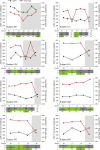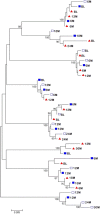Detection and molecular characterization of urinary tract HIV-1 populations
- PMID: 31551072
- PMCID: PMC6760049
- DOI: 10.1186/s12941-019-0326-9
Detection and molecular characterization of urinary tract HIV-1 populations
Abstract
Background: Identification of all possible HIV reservoirs is an important aspect in HIV eradication efforts. The urinary tract has however not been well studied as a potential HIV reservoir. In this pilot study we molecularly characterized HIV-1 viruses in urine and plasma samples to investigate HIV-1 replication, compartmentalization and persistence in the urinary tract.
Methods: Prospectively collected urine and blood samples collected over 12-36 months from 20 HIV-1 infected individuals were analysed including sampling points from prior to and after ART initiation. HIV-1 pol gene RNA and DNA from urine supernatant and urine pellets respectively were analysed and compared to plasma RNA viruses from the same individual.
Results: HIV-1 nucleic acid was detected in urine samples from at least one time point in 8/20 (40%) treatment-naïve subjects compared to 1/13 (7.7%) individuals on antiretroviral treatment (ART) during periods of plasma viral suppression and 1/7 (14.3%) individuals with virological failure. HIV-1 RNA was undetectable in urine samples after ART initiation but HIV-1 DNA was detectable in one patient more than 6 months after treatment initiation. There was co-clustering of urine-derived pol sequences but some urine-derived sequences were interspersed among the plasma-derived sequences.
Conclusions: Suppressive ART reduces HIV-1 replication in the urinary tract but HIV-1 DNA may persist in these cells despite treatment. A larger number of sequences would be required to confirm HIV compartmentalization in the urinary tract.
Conflict of interest statement
The authors declare that they have no competing interests.
Figures


References
MeSH terms
Substances
Grants and funding
LinkOut - more resources
Full Text Sources
Medical

